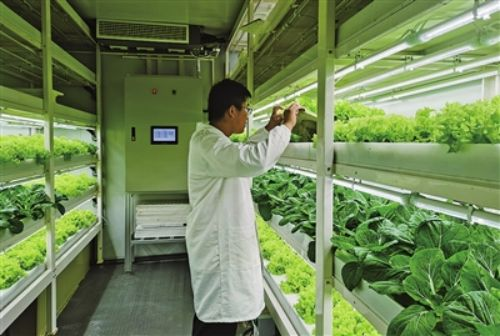Planting Vegetables in Containers
2023-11-24 14:58

Ten containers are arranged on the lawn of the Chongming Guangming Home Port Park. These containers do not belong to docks or oceans, but rather are plant factories with intelligent control systems. What secrets are hidden in these containers? Let’s go and take a look.
Walking into the container plant factory, what catches our eyes is a lush green area, with rows of vegetables growing neatly on the cultivation racks. Many lettuce seedlings have grown new leaves. Strawberries are about to mature... According to researchers, currently, the vegetables grown in container plant factories are mainly lettuce and cabbage, as well as some experimental crops such as ice vegetables, strawberries, tomatoes, cucumbers, etc. The vegetables here can achieve uninterrupted production throughout the year.
It is observed that container plant factories are different from traditional open-air agricultural planting methods. Each container is equipped with two doors, and the two doors cannot be opened at the same time when entering the container. These two doors serve as isolation transitions and can effectively prevent external pests from entering the plant growth zone.
The root system of all vegetables planted in the container plant factories draws nutrient solution from the culture tanks through the foam plates, and the growth cycle is also shorter than that of the traditional planting. In terms of water consumption, it saves about 90% compared to traditional cultivation. The vegetables grown here have a better taste and can be consumed directly.
Container plant factories use LED lights to control the brightness and temperature required for vegetable growth. Researchers have set the lighting duration from 7 am to 7 pm, which not only conforms to natural growth patterns but also facilitates timely observation of vegetable growth by researchers. It is understood that compared to traditional vegetable cultivation, this new planting method requires the use of AI technology, algorithms, and other means, known as container vertical agriculture.
In addition, Guangming Home Port has linked industrial and ecological resources in Chongming, becoming a comprehensive labor education practice base in Shanghai, allowing students to experience the transformation from traditional to modern agriculture. According to statistics, since its establishment, Guangming Home Port has received nearly 10,000 primary and secondary school students to participate in research and education activities.
In the future, Chongming Guangming Home Port will effectively empower agriculture through digital technology and artificial intelligence, allowing smart agriculture to have great potential in this fertile land of Chongming.